Tests
Serological tests
SeraSpot, ELISA, IFT, Immunoblot, and the immunoarray are serological methods for diagnosing infectious diseases. They identify antibodies or antigens

Serological methods
In our laboratory, we test for specific antibodies of various infections using SeraSpot, IFT, and ELISA methods. Generally, SeraSpot has a comparatively higher specificity and sensitivity than IFT and ELISA techniques. However, the formation of specific antibodies against Borrelia burgdorferi can be inhibited or suppressed by antibiotic therapy. Such cases can often be diagnosed using the EliSpot.
SeraSpot
The SeraSpot MicroArray for the determination of Borrelia burgdorferi antibodies combines the standardized and established ELISA technique with microarray analytics. Highly specific antigens of Borrelia burgdorferi are applied as spots onto the bottom of microtiter plate wells on a nanoliter scale. Controls are integrated into each well.
ELISA
The ELISA is a serological method used for detecting antibodies in biological samples. In this procedure, antigens are immobilized on a solid support, such as the bottom of a microtiter plate. The sample containing the antibodies to be tested is then added to the support. If specific antibodies are present in the sample, they bind to the immobilized antigens. After washing away the unbound substances, an enzyme-linked secondary antibody is added, which binds to the primary antibodies. Adding a substrate for the enzyme produces a measurable signal, providing information about the presence and quantity of specific antibodies in the sample.
IFT – Immunofluorescence Test
The Immunofluorescence Test is another serological method commonly used to identify antibodies against specific antigens. In this procedure, the antigens are applied to a solid support, similar to ELISA. The sample is then added to the support, and if specific antibodies are present, they bind to the antigens. Subsequently, a fluorescently labeled secondary antibody is added, which binds to the primary antibodies. Upon excitation with light of specific wavelengths, the fluorescently labeled antibodies emit light, which can be visualized with a fluorescence microscope. The presence of fluorescence indicates the presence of specific antibodies in the sample.
Immunoblot
The immunoblot, also known as Western blot, is an advanced method for identifying proteins in biological samples. In the case of infections, this method is often used to confirm the presence of specific antibodies against certain proteins or antigens. First, the proteins are separated by electrophoresis according to their size and then transferred onto a solid support, such as a nitrocellulose membrane. The sample is then applied to the support, and if specific antibodies are present, they bind to the corresponding proteins. Subsequently, the bound antibodies are visualized, often by adding an enzyme- or fluorescence-labeled secondary antibody and an appropriate substrate. The band patterns generated by the immunoblot can provide information about the presence and specificity of antibodies in the sample.
Immunoarray
The Immunoarray, also known as microarray, is an advanced serological method for detecting antibodies in biological samples. Similar to the SeraSpot MicroArray, the Immunoarray enables simultaneous analysis of a variety of antibodies against specific antigens. By using nanoliter amounts of samples, antigens can be immobilized on microarrays, enabling precise and highly sensitive analysis. This technology provides efficient and comprehensive characterization of the patient's immune response to infections such as Lyme disease and contributes to more accurate diagnosis and treatment.
Challenges in the serological diagnosis of Lyme disease:
Borreliosis infections cannot be completely ruled out due to negative serological test results. Laboratories should investigate for "VIsE" (acronym for: Variable major protein-like sequence Expressed) in ELISA and SeraSpot test systems. VIsE describes the ability of the "chameleon" Borrelia burgdorferi to permanently change its protein structure VIsE in vivo to prevent detection by the immune system. When searching for antibodies to Borrelia burgdorferi, VIsE has the highest sensitivity.
Study results and test comparisons
- „In the case of ELISA, positive or borderline results were observed in only 24 patients (53.3%).“(Wojciechowska-Koszko et al., Feb. 2011)
- „32 patients had specific antiborrelial antibodies confirmed by using the westernblot in spite of negative ELISA…In patients with persisting difficulties it is necessary to use the westernblot test…It is probably due to the very low production of specific antibodies caused also by the status of immune-deficiency detected in all our patients.“ (Durovska et al., 2010)
- „The number of IgM- and/or IgG-positive ELISA results…ranged from 34 to 59%...Comparison of immunoblots yielded large differences in inter-test agreement…Remarkabably, some immunoblots gave positive results in samples that had been tested negative by all eight ELISAs.“ (Ang CW et al., Jan. 2011)
The SeraSpot MicroArray analyzes the following Borrelia burgdorferi IgG and IgM antibodies and subspecies of Borrelia burgdorferi with high specificity:
VlsE (Borrelia burgdorferi afzelii), p39 (B.b. afzelii), p58 (B.b. garinii), p100 (B.b. afzelii), OspC (B.b. afzelii + B.b. garinii + B.b. sensu stricto), DbpA (B.b. afzelii + B.b. garinii + B.b. sensu stricto).
